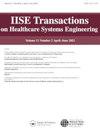Likelihood ratio-based CUSUM charts for real-time monitoring the quality of service in a network of queues
IF 1.5
Q3 HEALTH CARE SCIENCES & SERVICES
IISE Transactions on Healthcare Systems Engineering
Pub Date : 2023-04-06
DOI:10.1080/24725579.2023.2181470
引用次数: 0
Abstract
Abstract Queuing networks (QNs) are widely used stochastic models for service systems include healthcare systems, transportation systems, and computer networks. While existing literature has extensively focused on modeling and optimizing resource allocation in QNs, very little research has been done on developing systematic statistical monitoring methods for QNs. This paper proposes cumulative sum (CUSUM) control charts that monitor the queuing information collected in real-time from the QN. We compare the proposed methods with existing statistical monitoring methods to demonstrate their ability to quickly detect a change in the service rate of one or more queues at the nodes in the QN. Simulation results show that the proposed CUSUM charts are more effective than existing statistical monitoring methods. The motivation for this research comes from the need to monitor the performance of a hospital emergency department (ED) with the goal of monitoring delays experienced by patients visiting the ED. A case study using the data from the ED of a large academic medical center shows that proposed methods are a promising tool for monitoring the timeliness of care provided to patients visiting the ED.基于似然比的CUSUM图表用于实时监控队列网络中的服务质量
本文章由计算机程序翻译,如有差异,请以英文原文为准。
求助全文
约1分钟内获得全文
求助全文
来源期刊

IISE Transactions on Healthcare Systems Engineering
Social Sciences-Safety Research
CiteScore
3.10
自引率
0.00%
发文量
19
期刊介绍:
IISE Transactions on Healthcare Systems Engineering aims to foster the healthcare systems community by publishing high quality papers that have a strong methodological focus and direct applicability to healthcare systems. Published quarterly, the journal supports research that explores: · Healthcare Operations Management · Medical Decision Making · Socio-Technical Systems Analysis related to healthcare · Quality Engineering · Healthcare Informatics · Healthcare Policy We are looking forward to accepting submissions that document the development and use of industrial and systems engineering tools and techniques including: · Healthcare operations research · Healthcare statistics · Healthcare information systems · Healthcare work measurement · Human factors/ergonomics applied to healthcare systems Research that explores the integration of these tools and techniques with those from other engineering and medical disciplines are also featured. We encourage the submission of clinical notes, or practice notes, to show the impact of contributions that will be published. We also encourage authors to collect an impact statement from their clinical partners to show the impact of research in the clinical practices.
 求助内容:
求助内容: 应助结果提醒方式:
应助结果提醒方式:


